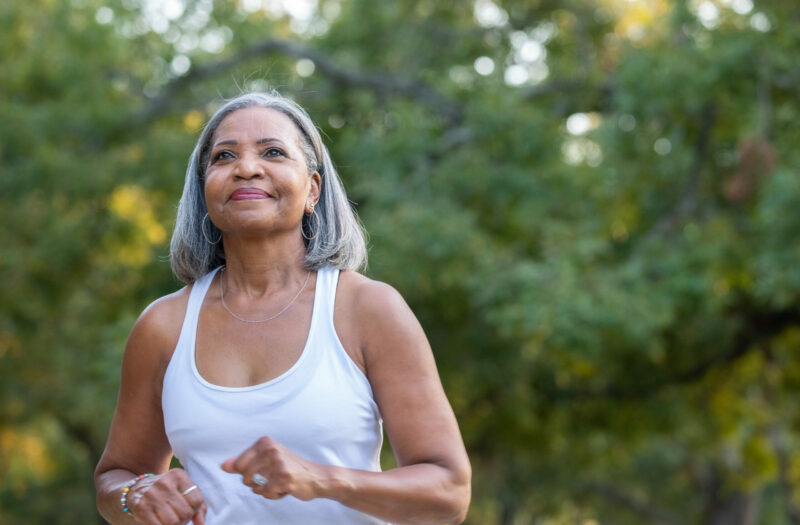Key Takeaways
- It’s important to stay active, even if you have a rheumatic disease.
- Only about half of older adults with rheumatic conditions are re getting regular exercise, and even fewer are doing vigorous activity.
- Being active has many benefits, including better functioning, less pain, and fewer sleep problems.
No matter your age, being physically active is essential to good health. The Centers for Disease Control and Prevention (CDC) recommends that adults aged 65 and up get at least 150 minutes a week of moderate activity or 75 minutes per week of vigorous activity. Doing strength-training activities at least twice a week, plus balance-building at least three times a week, is also advised.
Many older adults struggle to get adequate exercise for a variety of reasons, and living with a chronic condition such as arthritis can further complicate matters. The CDC advises that older adults with chronic conditions to “be as physically active as your abilities and conditions allow.”
The European League Against Rheumatism (EULAR) advises that clinicians consider personal factors, such as age, when making lifestyle recommendations for patients with rheumatism. EULAR’s latest guidelines suggest that people with rheumatic disease should aim for at least 150 minutes of moderate activity per week, along with strength exercises twice a week.
However, it is unclear whether most older adults with rheumatic disease are adhering to this guidance, or how their activity levels impact their health and quality of life.
To address these questions, a team of researchers conducted an analysis of data from the FORWARD database, a large databank of information on individuals with rheumatic disease. The results of their study were recently published in The Journal of Rheumatology.
How the Research Was Conducted
The researchers wanted to learn more about how activity levels affect older adults with rheumatic disease. They asked adults aged 65 and older about how active they were and put them into groups for the study. Then, they looked at how activity level related to how patients reported feeling. They used a survey called PROMIS-29 to ask patients about their daily activities (like running errands and climbing stairs), mood (like feeling anxious or sad), sleep quality, pain level, and social life.
Over 3,300 older adults with rheumatic disease were part of the study. Most of them (68%) had rheumatoid arthritis, but people with spondyloarthritis, osteoarthritis, and lupus were also included.
What the Study Found
The researchers found that just over half (54%) of the people in the study were doing moderate physical activity regularly. Only 14% were doing more intense physical activity.
People who did regular physical activity reported feeling better. Those who didn’t exercise enough had more pain and had a harder time sleeping, were more tired, and felt more depressed.
The study can’t prove that exercise causes these changes, but because exercise is known to be good for health, it makes sense that it could help with these issues.
It’s not clear if people who don’t exercise as much have more health problems because they don’t exercise or if they can’t be as active because they’re not as healthy. Other factors might also play a part.
“Though the reasons for lower level of [physical] activity in our cohort can be multifactorial, some of the potential factors related to clinical care are persistent disease activity, diagnostic delay leading to joint damage and disability,” wrote researchers.
The study brings to light the need for doctors to help people with rheumatic disease exercise more. “This could be an excellent opportunity for providers to educate and promote [physical activity] amongst elderly individuals,” they wrote, noting that using activity trackers, getting social support, and finding internal motivation could help people exercise more.
In short, exercising regularly is good for older adults with rheumatic disease. It can help with pain, fatigue, and sleep problems. Doctors can help by encouraging exercise and giving patients support and motivation.
What This Means for You
As we grow older, it can be tough to stay physically active. It’s even more challenging if you have a rheumatic condition, which can cause pain, fatigue, and joint problems. But even though it can be hard, it’s important to try to stay active. Even a little bit of exercise is better than none, and you can always start small and work your way up.
Official guidelines suggest aiming for 150 minutes of moderate activity each week. But if that sounds like too much, don’t worry. Just remember to move more and sit less during the day, even if it’s just taking a walk around the block or stretching for a few minutes. Every bit counts.
Gwinnutt JM, et al. 2021 EULAR recommendations regarding lifestyle behaviours and work participation to prevent progression of rheumatic and musculoskeletal diseases. Annals of the Rheumatic Diseases. 2023. doi: http://doi.org/10.1136/annrheumdis-2021-222020.
Kumthekar, A, et al. “Physical Activity Habits Among Older Adults Living With Rheumatic Disease.” The Journal of Rheumatology, January 2023, doi: https://doi.org/10.3899/jrheum.211244.






